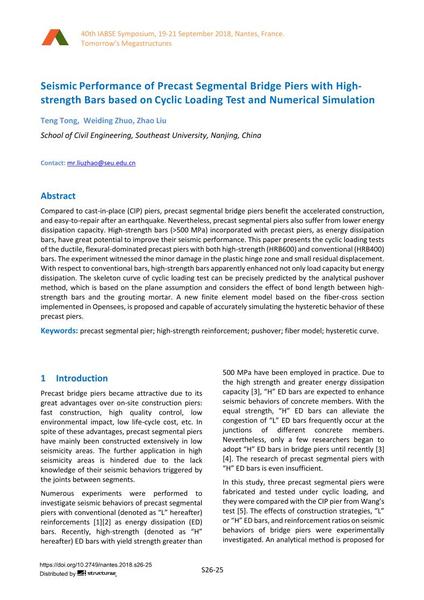Seismic Performance of Precast Segmental Bridge Piers with High- strength Bars based on Cyclic Loading Test and Numerical Simulation

|
|
|||||||||||
Bibliographic Details
| Author(s): |
Teng Tong
(School of Civil Engineering, Southeast University, Nanjing, China)
Weiding Zhuo (School of Civil Engineering, Southeast University, Nanjing, China) Zhao Liu (School of Civil Engineering, Southeast University, Nanjing, China) |
||||
|---|---|---|---|---|---|
| Medium: | conference paper | ||||
| Language(s): | English | ||||
| Conference: | IABSE Symposium: Tomorrow’s Megastructures, Nantes, France, 19-21 September 2018 | ||||
| Published in: | IABSE Symposium Nantes 2018 | ||||
|
|||||
| Page(s): | S26-25 | ||||
| Total no. of pages: | 8 | ||||
| DOI: | 10.2749/nantes.2018.s26-25 | ||||
| Abstract: |
Compared to cast-in-place (CIP) piers, precast segmental bridge piers benefit the accelerated construction, and easy-to-repair after an earthquake. Nevertheless, precast segmental piers also suffer from lower energy dissipation capacity. High-strength bars (>500 MPa) incorporated with precast piers, as energy dissipation bars, have great potential to improve their seismic performance. This paper presents the cyclic loading tests of the ductile, flexural-dominated precast piers with both high-strength (HRB600) and conventional (HRB400) bars. The experiment witnessed the minor damage in the plastic hinge zone and small residual displacement. With respect to conventional bars, high-strength bars apparently enhanced not only load capacity but energy dissipation. The skeleton curve of cyclic loading test can be precisely predicted by the analytical pushover method, which is based on the plane assumption and considers the effect of bond length between high- strength bars and the grouting mortar. A new finite element model based on the fiber-cross section implemented in Opensees, is proposed and capable of accurately simulating the hysteretic behavior of these precast piers. |
||||
| Keywords: |
pushover precast segmental pier high-strength reinforcement fiber model hysteretic curve
|
||||
